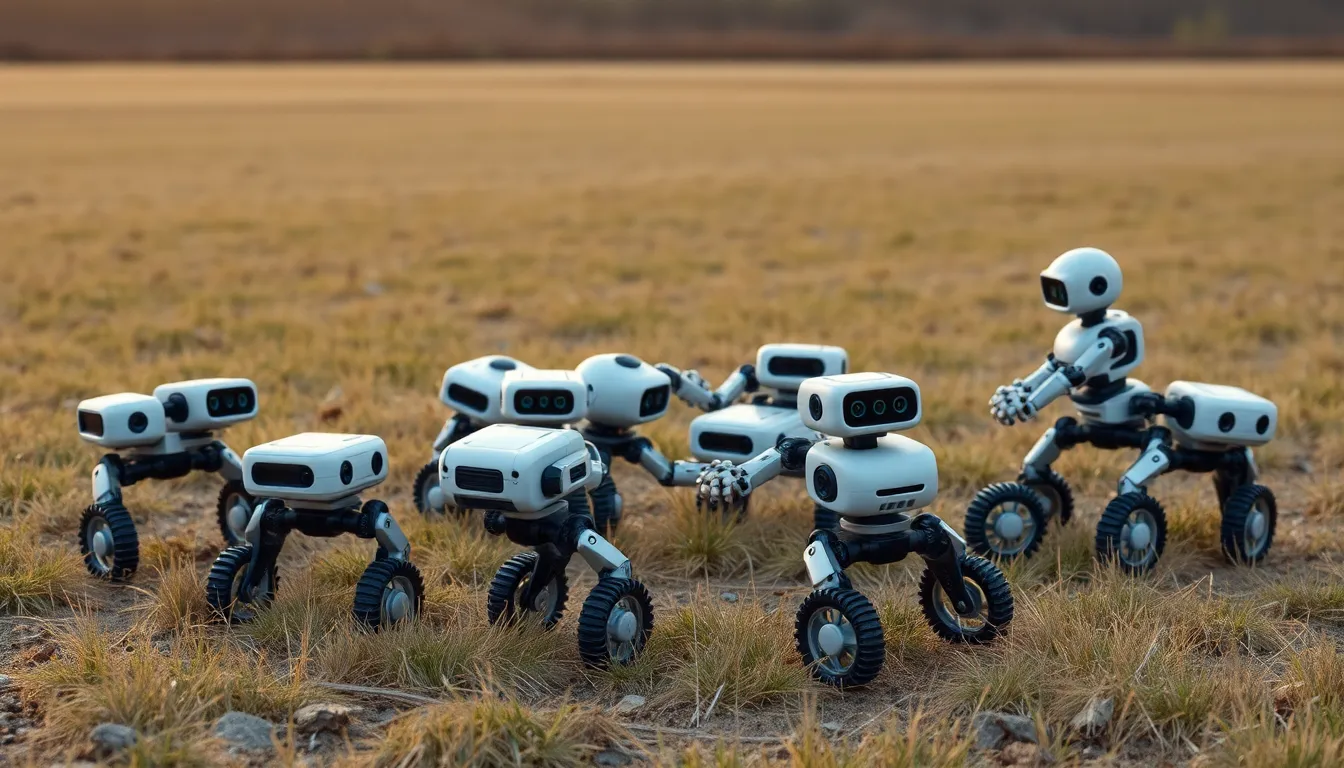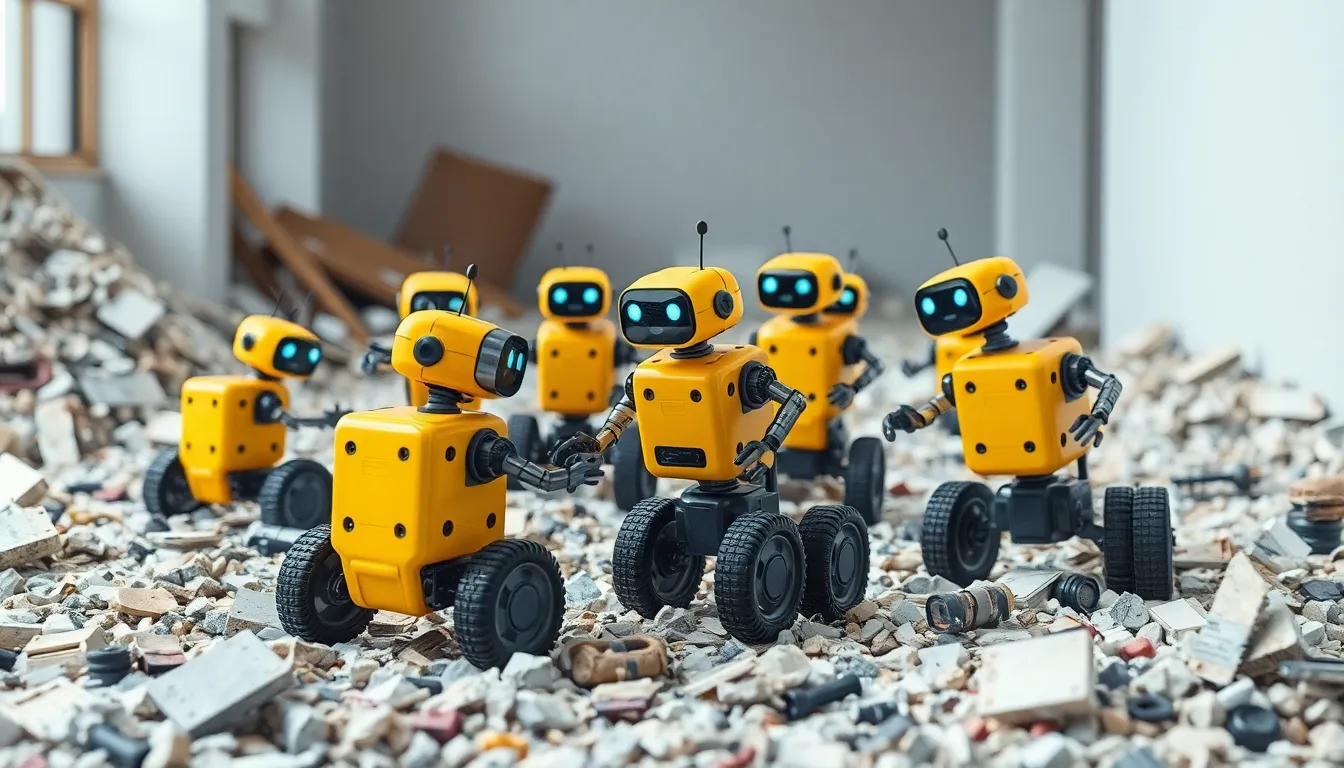Imagine a world where a swarm of tiny robots works together like a well-oiled machine, tackling tasks that would make even the most seasoned human sweat. That’s the magic of swarm robotics—a field that’s buzzing with innovation and potential. These little critters may not have wings, but they sure know how to fly through challenges by mimicking the collective behaviors seen in nature, like ants and bees.
Table of Contents
ToggleOverview of Swarm Robotics
Swarm robotics refers to the coordinated operation of multiple robots working collaboratively to achieve common goals. Inspired by nature, this technology mimics the collective behavior of social insects such as ants and bees. These small robots demonstrate remarkable ability to perform complex tasks, utilizing decentralized control and communication among themselves.
Autonomous units communicate using simple rules and local information, allowing adaptability to dynamic environments. Individuals in a swarm can share information quickly, enabling fast decision-making and task execution. For instance, a swarm of drones can efficiently map an area or monitor environmental conditions.
Various algorithms, such as particle swarm optimization, help enhance their collective performance. By utilizing these algorithms, swarms can effectively allocate tasks, optimize routes, and improve overall efficiency. Research indicates that swarm robotics can outperform individual robots in problem-solving and adaptability.
Practical applications of swarm robotics span multiple fields. Agriculture benefits from swarm techniques in crop monitoring and harvesting, while search and rescue operations utilize swarms to cover large areas swiftly. In manufacturing, swarms can improve automation processes, increasing productivity and reducing operational costs.
Moreover, ongoing research explores integrating swarm robotics with artificial intelligence. This combination aims to enhance decision-making and problem-solving capabilities further. As advancements continue, swarm robotics holds significant promise for future applications in both industrial and everyday contexts.
Key Principles of Swarm Robotics

Swarm robotics operates on several core principles that drive its effectiveness. The concepts of decentralization and self-organization stand out in enabling robots to cooperate efficiently.
Decentralization
Decentralization minimizes reliance on a single controlling entity. Each robot possesses autonomous decision-making capabilities. Communication occurs within a network of robots, allowing rapid information sharing. This structure supports adaptability in dynamic environments. For instance, if one robot encounters an obstacle, others adjust their tasks accordingly. This flexibility enhances the overall robustness of the robotic swarm. Studies show that decentralized systems often lead to better outcomes in task completion, as robots can strategize collaboratively without waiting for directives.
Self-Organization
Self-organization ensures robots operate cohesively without centralized control. Individual robots respond to local information, leading to emergent behaviors. Each robot follows simple rules that contribute to complex group dynamics. The interactions among robots lead to efficient task allocation and area exploration. Examples include how swarms can effectively segregate into subgroups to tackle multiple challenges simultaneously. Research indicates that self-organized systems improve scalability and efficiency in various applications. As robots adapt to changing conditions, they maintain coordination, ensuring successful execution of collective goals.
Applications of Swarm Robotics
Swarm robotics finds extensive applications across various industries, demonstrating its versatility and efficiency in tackling complex tasks.
Industrial Automation
Industrial automation benefits significantly from swarm robotics. Numerous small robots can work alongside each other on assembly lines, optimizing production processes. These robots improve task allocation, enabling them to adapt to unforeseen changes swiftly. For instance, if one robot encounters an obstacle, others in the swarm can immediately adjust their actions to maintain workflow. This decentralized system minimizes downtime and enhances overall productivity. Moreover, significant reductions in labor costs and errors occur as robots perform repetitive tasks consistently and accurately.
Environmental Monitoring
Environmental monitoring is another vital application of swarm robotics. Small, autonomous robots can cover vast areas, gathering data on air and water quality. They collaborate to deploy sensors efficiently, allowing for real-time monitoring of ecosystems. By sharing collected information, robots create comprehensive maps of the monitored environment. Swift response to environmental changes becomes possible, aiding in drought detection or pollution monitoring. The collective effort of these tiny robots ensures timely data collection and analysis, providing valuable insights for conservation efforts.
Search and Rescue Operations
Search and rescue operations utilize swarm robotics for enhanced efficiency. In disaster scenarios, numerous small robots can navigate debris fields collaboratively, searching for survivors. Each robot assesses its surroundings, relaying crucial information back to operators. Rapid deployment of resources occurs as robots identify areas of interest effectively. The flexibility of robotic swarms allows them to reach confined spaces, fulfilling roles that human responders cannot. Continuous communication among robots enhances situational awareness, leading to quicker, more effective rescue missions.
Challenges in Swarm Robotics
Swarm robotics faces several challenges that can impact effectiveness and application. Two prominent issues are communication and scalability.
Communication Issues
Communication among robots remains a significant hurdle. Effective information exchange is vital for coordinated actions. Limitations in bandwidth or signal interference can disrupt data flow. Moreover, the complexity of messages required for task sharing can lead to confusion. Real-time decision-making relies on clear communication, and any delay can hinder performance. Solutions like advanced algorithms and redundancy may improve communication reliability, yet achieving seamless interaction among numerous robots still proves challenging.
Scalability
Scalability presents another critical concern in swarm robotics. As the number of robots increases, maintaining efficient operations becomes harder. Performance can decline due to congestion in communication channels and resource limitations. Coordination among a larger group requires more sophisticated algorithms. Additionally, task allocation becomes more complex, potentially leading to inefficiencies. Research aims to develop strategies that ensure effective performance across varying group sizes. With innovative approaches, successful scalability can enhance swarm robotics’ capabilities in larger applications.
Future Trends in Swarm Robotics
Advancements in swarm robotics may lead to significant improvements across various sectors. Researchers anticipate increased integration of artificial intelligence, enhancing autonomous decision-making capabilities in robots. This evolution allows robots to analyze environments and adapt their strategies in real time for complex tasks.
Emerging technologies improve communication among swarm members. These innovations include advanced algorithms that enhance data transfer efficiency, addressing bandwidth and complexity issues. By facilitating seamless interaction, robots can coordinate actions more effectively, improving overall performance.
Sustainability stands as a priority in future developments. Researchers explore environmentally friendly materials and energy-efficient designs to reduce the ecological footprint of swarm robots. These considerations help align robotics with current environmental goals.
Growth in manufacturing processes illustrates another trend. Swarm robotics can further enhance efficiency on assembly lines, enabling swift adaptations to changes in production needs. This flexibility supports cost reduction while increasing output.
Exploration in hazardous environments presents additional applications. Swarm robots play an essential role in surveying areas deemed unsafe for humans, such as disaster-stricken zones. The ability to navigate and assess situations collaboratively enhances safety and effectiveness during rescue missions.
Collaboration between academia and industry may drive innovation in swarm robotics. Public and private partnerships foster knowledge exchange, leading to the development of more advanced robotic systems. Such collaborations encourage the exploitation of research findings in real-world applications.
Progress in swarm robotics continues to evolve, highlighting its impact across various fields. Ongoing studies maximize scalability and reliability, addressing existing challenges. The focus on refining swarm intelligence ensures robots can tackle increasingly complex tasks in dynamic environments.
Swarm robotics stands at the forefront of technological innovation, showcasing how collective behavior can transform various industries. Its ability to adapt and operate autonomously offers significant advantages in efficiency and cost reduction. As research continues to tackle challenges like communication and scalability, the integration of artificial intelligence promises to further enhance these systems’ capabilities.
Looking ahead, the potential for swarm robotics to revolutionize fields such as agriculture, environmental monitoring, and search and rescue is immense. By prioritizing sustainability and collaboration between academia and industry, the future of swarm robotics is not just about technological advancement but also about creating solutions that benefit society as a whole.





